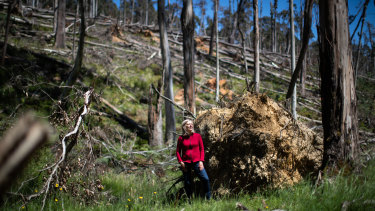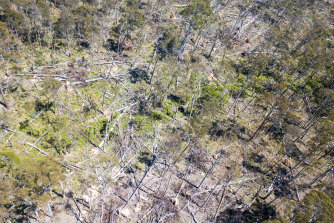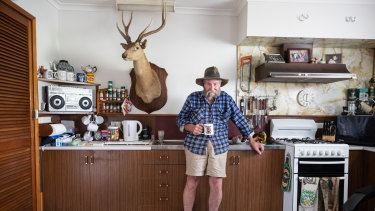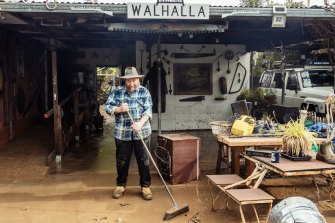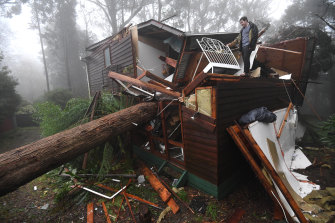Home » World News »
Mounting costs, a forest ‘like matchsticks’ six months after severe storms
Gayle Osborne is still surrounded by the damage left behind by the ferocious storm that tore across Victoria in June.
From her home nestled in the Wombat State Forest near Glenlyon, she need not look far to see the many scars the landscape still bears.
“I’m looking out at trees scattered everywhere,” she said.
Gayle Osborne in the Wombat State Forest. Credit:Jason South
The wild weather trashed forests, slammed massive trees onto houses in the Dandenongs and flooded homes in Traralgon.
Six months later, councils and households are still assessing the financial and personal toll of the extreme weather event while they continue the clean-up job, which is far from over.
While government agencies have cleared more than 4700 kilometres of public roads, works are planned to clear a further 1800 kilometres of roads.
Earlier this month the Victorian government committed $73 million for ongoing repairs and recovery. The storm and floods affected two million hectares of public land across the Macedon, Yarra and Dandenong ranges and parts of Gippsland.
Authorities estimate it could take two years to clear the debris and fallen trees that remain strewn across the Wombat State Forest.
Ms Osborne, who is convenor of Wombat Forestcare, said while some tracks in her area remained closed due to the storms, she was more concerned about the wildlife.
She fears threatened species including the greater glider have lost much of its habitat, which was severely damaged.
“In two areas where we’ve got greater gliders it’s just like matchsticks,” she said. “Our biggest concern is that greater gliders were probably hanging on anyway, and then they’ve had this event knocking out some of their habitat.”
The damage left behind by the June storms. Credit:Jason South
Forest Fire Management Victoria chief fire officer Chris Hardman said his teams determined where works were needed to best manage potential bushfire risk.
“Our priority has been to ensure roads and fire access networks are clear and safe, as rapid access is essential for fire suppression,” he said.
Hepburn Shire councillor Brain Hood, whose ward includes Trentham, said the shire was spending about $1 million dollars a month, having already laid out $2.8 million in the three months to September on recovery works.
“It is easy for people to underestimate just how much damage was done,” he said. “It was enormous.”
Cr Hood said the council was working with the state government and other agencies to determine how much of that money it will get back.
An aerial view of flooding in the township of Traralgon in Gippsland. Credit:Blake Bourne
The Latrobe City Council area was savaged by the storm and flooding; 138 buildings were destroyed after the Traralgon Creek burst its banks.
Of more than 990 cases registered for help immediately after the storm, 440 cases remain open, receiving support from council caseworkers funded by Bushfire Recovery Victoria.
The council cleared more than 350 kilometres of roads after the June storms. It expects the total cost of remediation works will run into the tens of millions of dollars.
Les Davidson has just moved back into his house after it was flooded in June. Credit:Jason South
Traralgon resident Les Davidson only moved back into his home early this month after water flooded his house and yard in June.
In the six months after the storm, he suffered two heart attacks, which he believes were triggered by stress from the event and moving between hotels and caravans while his house was being repaired.
“I think it was anxiety that brought the stress on,” he said. “I still can’t sleep properly.”
Les Davidson sweeps water in the front yard of his home in June.Credit:Blake Bourne
Mr Davidson, 62, has lived through five floods in Traralgon but the June event was the worst he’d experienced. He had to be rescued by a fire truck as the water rose inside his house.
Mr Davidson wants a siren system introduced to warn residents when floodwaters may threaten their homes.
Latrobe City Council mayor Kellie O’Callaghan said some sporting groups would have to be permanently relocated from the Traralgon Recreation Reserve, which was flooded badly.
A tree through a house in Olinda in the Dandenongs after the June storms. Credit:Joe Armao
Some residents were still struggling to clean up their properties as some of the biggest trees came down on private land, she said. “Even cleaning up one of those trees will be a significant job.”
A guide to the environment, what’s happening to it, what’s being done about it and what it means for the future. Sign up to our fortnightly Clear Air newsletter here.
Most Viewed in National
From our partners
Source: Read Full Article
